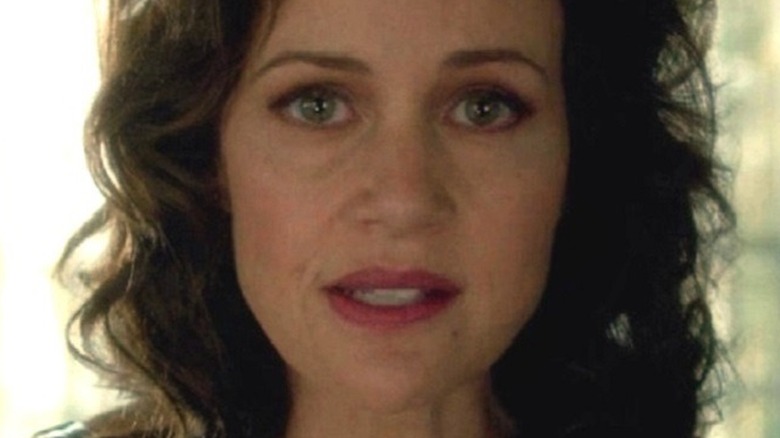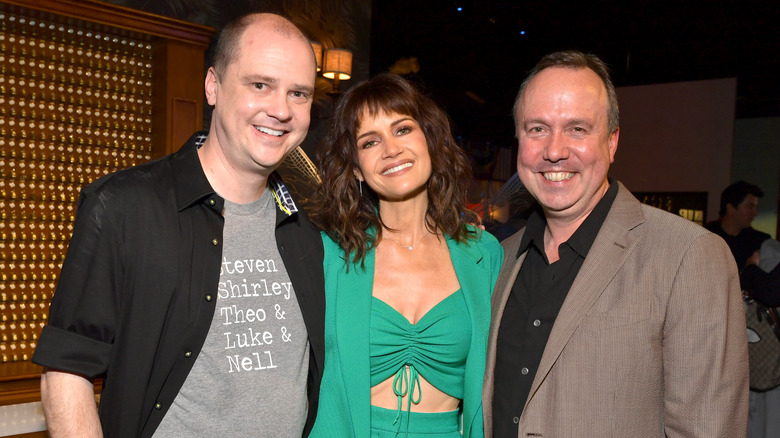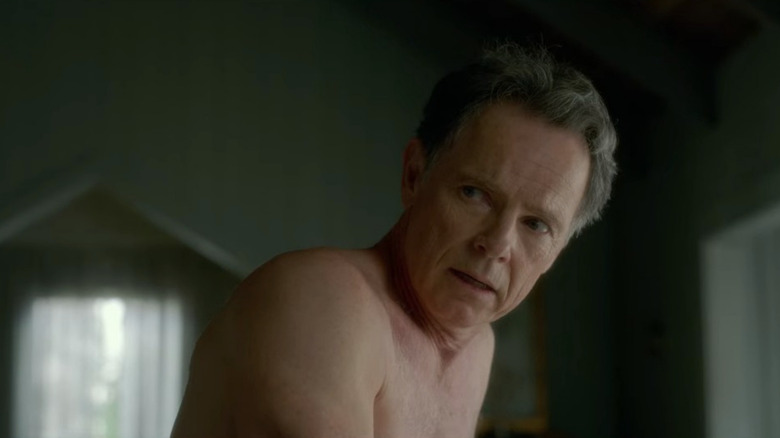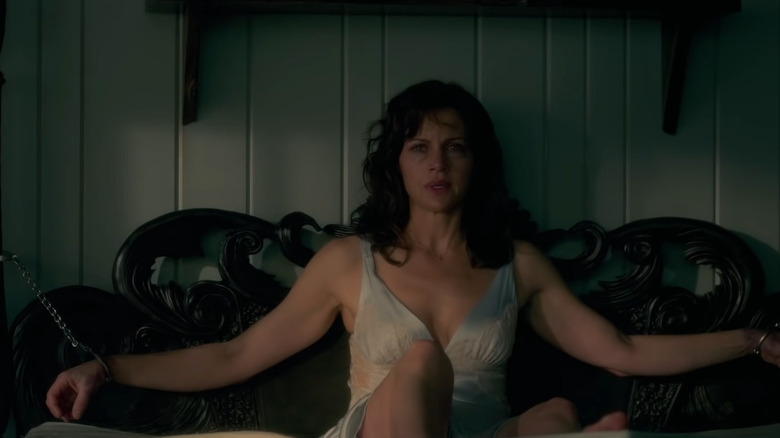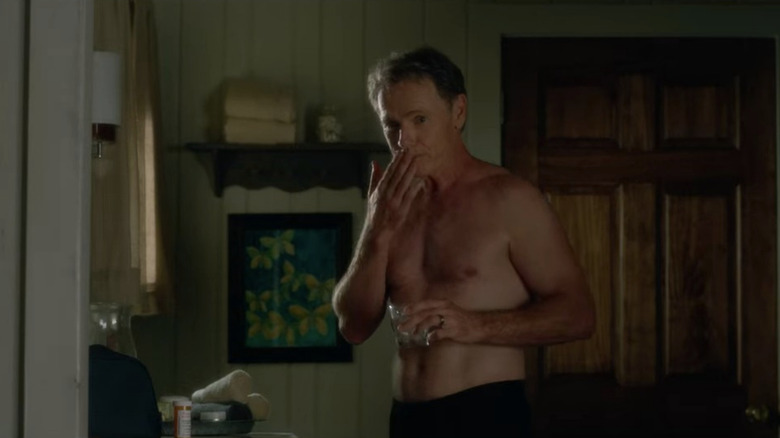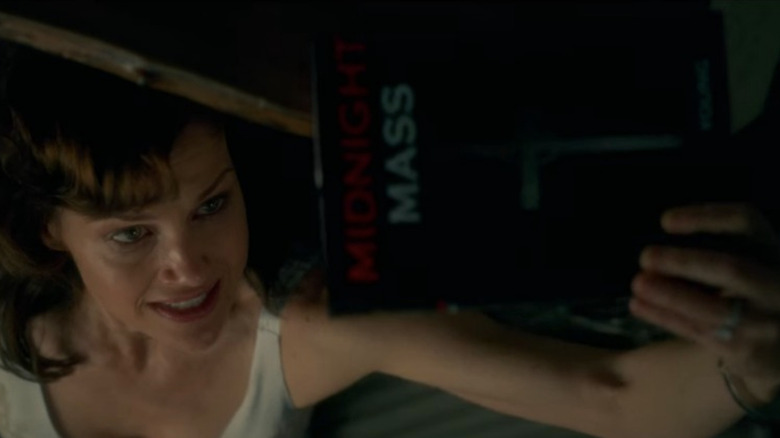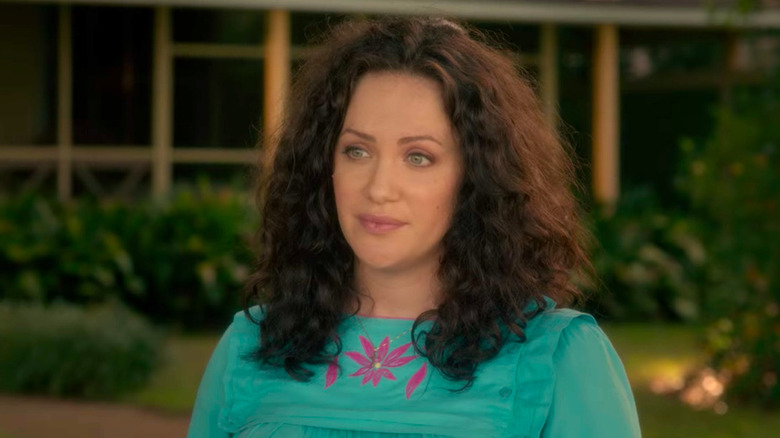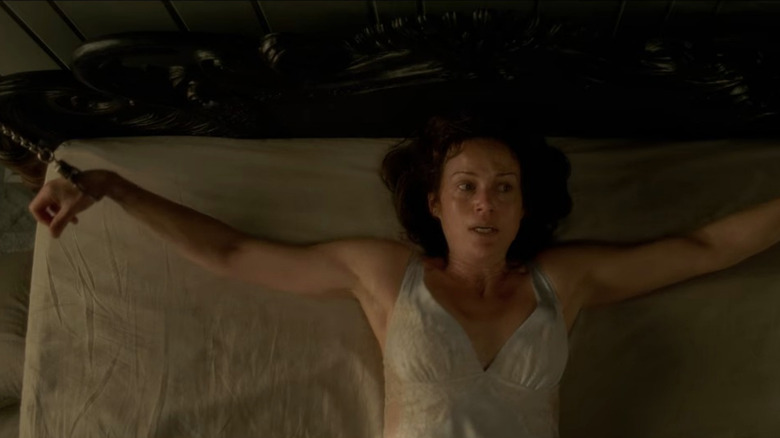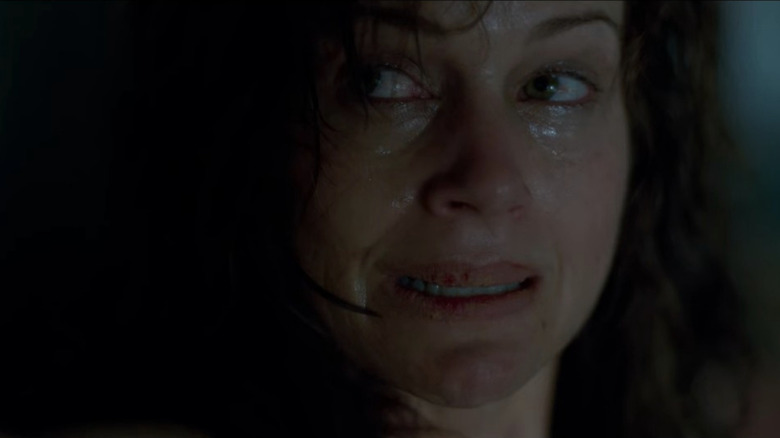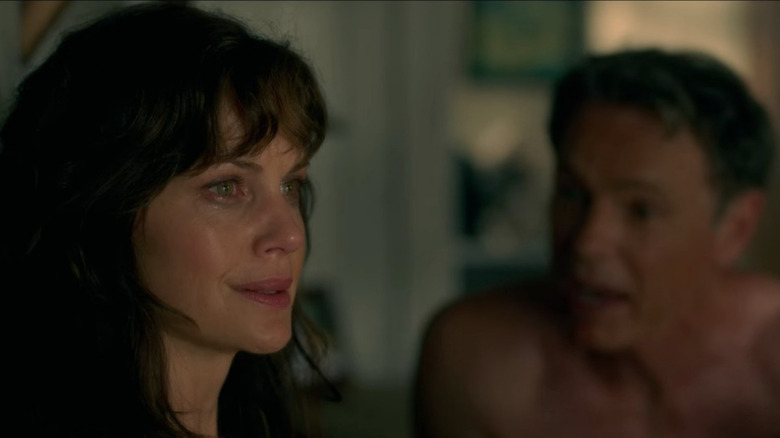The Untold Truth Of Gerald's Game
These days, writer/director Mike Flanagan is best known for his popular Netflix shows "The Haunting of Hill House," "The Haunting of Bly Manor," and "Midnight Mass" — fantastic series about love, loss, and grief. Of course, true Flanagan-heads also know the director for his incredible films. His first feature to receive critical acclaim was 2016's "Hush," which stars his wife, Kate Siegel, in the lead role. And then in 2017, he released "Gerald's Game," a Stephen King adaptation and something of a hidden gem in his filmography.
"Gerald's Game" stars "Hill House" and "Bly Manor" alum Carla Gugino as Jessie, a woman on a romantic getaway with her husband, Gerald (Bruce Greenwood). When Gerald dies in the midst of their role-playing, Jessie is left handcuffed to a bed and must fight her own demons if she's to survive. "Gerald's Game" is a surprisingly good Stephen King adaptation, especially considering the interiority of the source material. If you haven't seen "Gerald's Game" yet, you should probably go watch it first. But otherwise, you're in the right place if you want to discover the fascinating secrets behind the film. Keep reading to discover the untold truth of "Gerald's Game."
Mike Flanagan called Gerald's Game unfilmable
Stephen King's 1992 book "Gerald's Game" isn't one of his best-known works. Nonetheless, it's always been a favorite of Flanagan's despite his initial assumption that a movie adaptation was out of the question. In fact, speaking with The Independent, Flanagan even went so far as to say, "When I was in college I read the book and thought it was amazing but unfilmable. ... The book, as it's written, is really impossible to adapt." The trick, according to Flanagan, was finding some sort of angle that would make the story work in a cinematic context.
What Flanagan eventually came up with was the idea of giving life to Jessie's inner monologues. After all, having the film take place entirely inside of Jessie's head wouldn't be that interesting to watch, so Flanagan and his team essentially personified her innermost thoughts. How so? Well, Gerald dies almost immediately in the book and is never heard from again, so to make things more dynamic, Flanagan decided to bring Gerald back by having him represent a facet of Jessie's consciousness.
Plus, Jessie interacts with another version of herself, which allows our hero to express her thoughts out loud. As producer Trevor Macy put it, "In the book, there are characters that can be best described as representing facets of Jessie's past and her personality. In the movie, we channel those." While we're certain the talented Carla Gugino could've pulled off the film entirely on her own, the addition of other characters such as Greenwood's Gerald and even the stray dog definitely make for a more interesting movie.
One of the lead actors was suggested by Stephen King
Though Mike Flanagan never met his hero, Stephen King, while working on the film, King did have a major influence on the film's production. Flanagan told The Independent that it was actually King himself who suggested Bruce Greenwood for the role of Gerald. Greenwood had starred in a musical that King had written and produced called "Ghost Brothers of Darkland County," and he'd been a fan of the actor ever since. Flanagan had also been a fan of Greenwood's since he'd seen him in a film called "The Sweet Hereafter," so casting him was a no-brainer.
It was more difficult to cast the role of Jessie, according to Flanagan and producer Trevor Macy. As Flanagan put it, "Either the part would be irresistible to an actor or put them off." Carla Gugino was quite busy at the time, but she was able to fit the film into her packed schedule. "She embraced the project so passionately, it was really exciting," the director explained.
We imagine it wasn't as difficult to cast the part of Jessie's mother in the flashback sequences, however, as that role went to Flanagan's wife, Kate Siegel. Meanwhile, the role of Jessie's father went to Henry Thomas, who would go on to star in "The Haunting of Hill House," among other Flanagan projects.
Stephen King loved the film
Though Stephen King's books have been adapted dozens of times, he never seems to tire of the Hollywood process. According to producer Trevor Macy (via The Independent), King is very involved with every adaptation of his work, and "Gerald's Game" was no different. He was shown the script ahead of time, and he was also sent a rough cut of the film. Luckily for Macy and Mike Flanagan, King was a fan of their adaptation and even tweeted about how much he liked it after he saw the first cut.
For a longtime King fan like Flanagan, this support meant everything. "He loved the film," Flanagan said. "I literally printed his email out and framed it and put it in the living room." Though not every Stephen King adaptation is a total success, having the author himself be a fan is certainly a mark in the plus column. Of course, King was famously not a fan of Kubrick's take on "The Shining," so perhaps authorial support isn't everything.
One of the biggest changes from book to movie
In Stephen King's book, Jessie is naked for most of the story, making her vulnerable state –- she's also handcuffed to the bed –- even more apparent. According to co-writer Jeff Howard, there were conversations early on about how that aspect of the book might be adapted to film. Howard told /Film that he and Mike Flanagan decided pretty quickly that it wouldn't work to have Jessie nude for the entire film. It would've meant a constant discussion of the tricky camerawork necessary to hide the nudity. "It would've just become very strange, and no one would have done it, and no one would want to see it," Howard explained. Instead, they decided to have Jessie wear a negligee for the entire film and make it a plot point in and of itself.
Flanagan and Howard also came up with a clever take on Gerald's presence in the film. Instead of having the female character nude and the male character clothed, the roles were switched. While Jessie is mostly covered up in her slip, Gerald spends much of the film in his underwear. Gugino and Greenwood spoke with Bloody Disgusting about how it wouldn't make sense to have Jessie's hallucinatory version of Gerald be clothed, with Gugino noting it would actually be strange to see him totally covered up.
The 2010s made things tricky
Stephen King's book originally came out in 1992, and it's also set around that time. The film, on the other hand, was released in 2017, and this meant writers Jeff Howard and Mike Flanagan had to adjust a few things to fit the time period. One of the more contemporary elements in the film is easy to overlook: the Viagra. Speaking with /Film, Howard noted that Viagra didn't actually exist in 1992, or if it did, "only the CIA had it." The addition of that magical blue pill actually helped their adaptation of the story, according to Howard. "I think it helped take away some of the physicality of the relationship that's in the book that is not necessary to the spirit of the story," he explained.
One of the most significant and obvious differences between the two time periods is the existence of cell phones. As Howard noted, cell phones have changed movies in a huge way, especially in the horror genre. However, it wasn't all that hard for Howard and Flanagan to deal with the technology problem. As Howard put it, "Fortunately, a story set in a remote cabin on a getaway with a lady handcuffed to a bed does lend itself to not being able to reach a cell phone." Much of the film's action revolves around Jessie trying to grab things that are just out of reach, so her cell phone being one of these objects makes perfect sense.
That Mike Flanagan Easter egg
From "Doctor Sleep" to "The Haunting of Hill House," a lot of Mike Flanagan's works are literary adaptations. And, of course, "Gerald's Game" is based on Stephen King's novel of the same. However, "Midnight Mass" and "Hush" are two Flanagan projects that are original stories. "Midnight Mass" focuses on a dying island town and the arrival of a magical priest, and "Hush," which stars and was co-written by Katie Siegel, follows a deaf woman being stalked by an intruder.
You might not think any of these projects are connected to one another, but an Easter egg in "Gerald's Game" proves otherwise. In "Hush," the main character, Maddie (Siegel), is a writer, and her most recent book is called "Midnight Mass." Her friend Sarah (Samantha Sloyan) specifically mentions liking two characters named Riley and Erin. Riley and Erin are also characters in the "Midnight Mass" Netflix series, and Erin is actually played by Siegel herself (who also happens to be Flanagan's wife).
Meanwhile, Carla Gugino's Jessie also has a connection to the book. While trapped in the cabin with her dead husband, a stray dog enters the room and begins gnawing on Gerald's body. In order to get the dog to stop munching on her husband's corpse, Jessie grabs something from the shelf above her to throw at the dog. She happens to grab a book entitled –- you guessed it –- "Midnight Mass." Does this mean these films share a universe? That's up to you to decide, though it's certainly not the first time horror films have shared universes.
Kate Siegel was nine months pregnant while filming
While most of "Gerald's Game" takes place in the bedroom Jessie's trapped in, there are a few scenes that involve a change of scenery. Jessie spends her time handcuffed to the bed lost in her own mind, and some of this introspection includes flashbacks –- or hallucinations –- of her youth. By the end of the film, Jessie has realized she's been repressing traumatic memories from her childhood, namely the fact that her father molested her for years. She also comes to the realization that her mother suspected what was going on but never did anything about it.
If you're a fan of Mike Flanagan's work, you've probably realized that his wife, Kate Siegel, is featured in some capacity in almost all of his projects. "Gerald's Game" is no exception, as Siegel plays Jessies' neglectful mother in the flashback sequences and hallucinations. It's a fairly small role, but it wound up being pretty challenging for Siegel to play. Siegel happened to be nine months pregnant during the shoot, and she remembers feeling pretty nauseous while they were filming.
Nevertheless, she remained committed to the role and also committed to showing pregnancy in a realistic light. "I remember saying early on to Mike, 'Don't glam me up. I want the frizzy hair. I want to be glowing and sweating. I don't want any of this pretend-glorifying-of-motherhood B.S,'" she told Entertainment Weekly. Looking back, however, Siegel has said she does wish she was slightly more glammed up.
If you or anyone you know has been a victim of sexual assault, help is available. Visit the Rape, Abuse & Incest National Network website or contact RAINN's National Helpline at 1-800-656-HOPE (4673).
Carla Gugino had to be handcuffed to a bed for three weeks
It's pretty obvious watching "Gerald's Game" that it must've been a difficult shoot for lead actress Carla Gugino, and she certainly agrees with the sentiment. Speaking with Den of Geek, Gugino said, "It was one of the hardest, most challenging shoots I've ever done, which is saying a lot." The reason for the difficulty of the shoot is pretty clear: Gugino had to be handcuffed to a bed for three weeks, for hours on end.
Gugino spoke with Bloody Disgusting about the experience of being physically restrained for most of the shoot. Gugino noted that it was difficult because it was physically uncomfortable, and she would get bruises from the handcuffs. It also meant she couldn't move around and be physical like she normally would. At the same time, Gugino also explained how these restrictions helped her stay emotionally present. "It allowed in terms of that sense of needing to escape oneself and the chatter in our minds and those voices that we can't get away from and being forced to deal with them," she explained. "The physical restriction is very helpful for that."
In the same interview, Mike Flanagan highlighted Gugino's incredible work ethic and discussed his belief that he'd never ask an actor to do something he wouldn't do himself. In that vein, he decided to try on the handcuffs himself in order to put himself in her shoes, but he only lasted five minutes before he had to take them off. "Five minutes was all I could take, and Carla was in them for three weeks," he recalled in awe.
The de-gloving sequence was difficult to film
There's one scene in "Gerald's Game" that could probably be in the running for one of the grossest scenes in horror history. If you've seen the film, you can likely guess what we're referring to. After being trapped in the handcuffs for several days, Jessie realizes the only way to escape is if she slices her wrist and pulls the handcuff off. She succeeds in slicing her wrist open, and as she pulls the handcuff off, the skin of her hand comes off with it.
It's a grueling scene to watch, and it turns out it was just as grueling to film. Gugino told Bloody Disgusting, "It was technically challenging because when we wanted shots of my hand and face together, and there were quite a few of those, we had to have the cuff tight enough so that it didn't look like it was easy to pull out of it." Though Gugino obviously wasn't ripping her own skin off, it was still quite harrowing. "We basically did it as tight as I could handle it which meant that it was really painful but could actually get through so it was a brutal sequence to perform," she explained.
Gugino praised the prosthetic hand that was used for the scene and noted that all the physical discomfort totally paid off in the end. Gugino went on to say that she's not normally a masochist but that she felt she needed to push herself to the limit for the scene in order to make it feel real.
Gerald's Game was shot chronologically
Because of the variable nature of sets, locations, and actors' availability, movies often aren't shot chronologically or in the sequence laid out in the script. "Gerald's Game" is a low-budget film shot mostly in a single location, which meant the filmmakers were able to do things a little differently. For one, they shot the entire movie in chronological order. In some ways, this was quite helpful, as Jessie gets more and more desperate as the days and hours go on. But, at the same time, it was still quite difficult for Carla Gugino because she was often playing different versions of herself –- essentially personified versions of her subconscious -– in the same day.
In order to give the actors time to prepare during their 24-day-long shoot, Mike Flanagan would block out an hour of rehearsal every day, Gugino told The A.V. Club. They'd rehearsed every single scene in the film, so when it came time to shoot, everyone was prepared. Gugino explained what's so great about Flanagan's directing style is that he lets the actors explore. If something they'd worked out in rehearsals didn't coincide with his shot list, he would adjust accordingly. Nevertheless, as Gugino put its, "When you watch the film, you see that it's really precise." After all, everyone on the set was extremely focused and at the top of their game.
